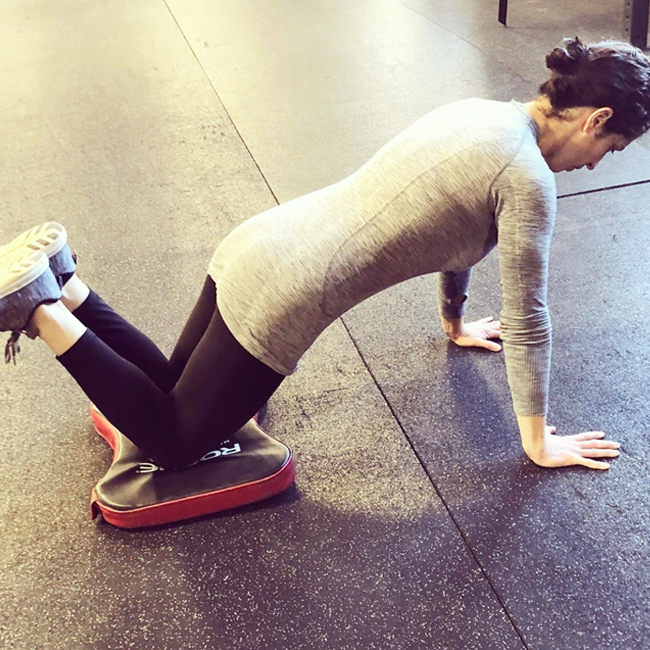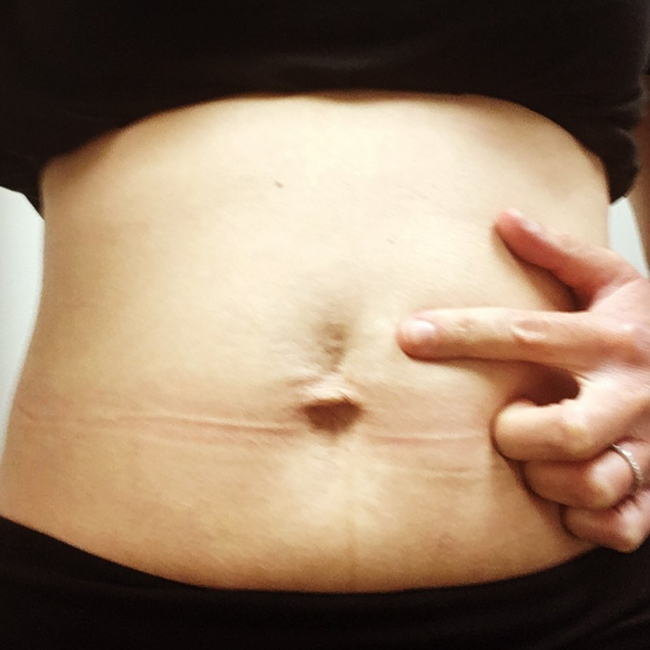I think every post-partum woman should have pelvic floor therapy covered; it should be part of the whole birth experience, and post-partum care. I went to pelvic floor therapy before becoming pregnant with Collins, and then after giving birth to her, and I plan to do that after each of my pregnancies (if I can be so blessed). But I’m often surprised how little this necessity is talked about. Many people don’t even have the knowledge that this is an option, or that this is something we should do. And many women from our mother’s and grandmother’s generations have silently suffered from this lack of knowledge. So, when we know better, we do better, right?! If you have the means, please, go to pelvic floor therapy!
And now, let’s get everyone’s questions answered by Rachel Parrotta, who is a Pelvic Health Physical Therapist based in Long Island, New York, or shall I say on Long Island. Rachel is all about empowering people in pregnancy and post-partum, and doing so by focusing on pelvic health!
This interview is intended for informational and educational purposes only and not for the purpose of rendering medical advice. Please consult your physician for personalized medical advice.

Rachel, thank you so much for agreeing to talk with me and help spread the word about pelvic floor health! Can you start off by telling us a little about you personally and professionally?
Thank you for inviting me to chat! I am a Long Island native and mom to two boys, two and four-years-old. Our family recently returned to Long Island after six years of living in New York City. We have been slowly introducing the boys to the activities we love, such as skiing and hiking. Hopefully one day we will make our way to explore the Canadian Rockies!
I have been a Pelvic Health Physical Therapist for the past twelve years. Although I have always been passionate about my work, going through my own experiences of pregnancy, birth, and post-partum has definitely heightened my commitment to supporting people during these vulnerable times. My absolute favorite thing is to help clients develop a road map for returning to the activities that they love, after pregnancy.
There are a million and one questions I want to ask you, and that were sent in from others on Instagram, but I will try to not take up your whole week, I promise! Can you tell us why our pelvic floor is important? I know you focus on pregnancy and post-partum, but I believe it’s also true that women who have never been pregnant, and even men, can experience pelvic floor issues. Who should be looking into assistant for this?
Yes! EVERYONE has pelvic floor muscles! But because we do not learn about them in school or while training for sports, they often do not function as efficiently as other parts of our body. Both men and women can experience challenges related to pelvic floor muscle dysfunction.
Outside of pregnancy and birth, many people develop challenges related to the pelvic floor muscles being OVER-engaged, or ‘too tight’. Symptoms related to pelvic floor muscle over-engagement include pain with urination or bowel movements, pain with sexual activity, urinating frequently, and pelvic pain localized to the vulva, penis, or scrotum.
It is also common for female athletes, who have never had babies, to leak urine during exertion in their sport. One recent study showed that approximately 1 in 3 Olympic-level Rhythmic Gymnasts reported urinary incontinence, yet 70% of the athletes reported that they had never even heard of the pelvic floor!
Are there certain pregnancies and births that should look into pelvic floor therapy more than others, or is it important for everyone? Is it important if you had a caesarean-birth as well?
Yes! The term ‘pelvic floor therapy’ can be misleading, as we look at more than just the pelvic floor muscles. In every pregnancy, the core, pelvic floor, and hip musculature undergo changes to adapt to the demands of the growing baby. Every post-partum person would benefit from seeing a PT and receiving a personalized recovery program.
In the case of Cesarean-birth, there are many additional considerations. Many people who experience a Cesarean-birth also spent multiple hours ‘pushing’ in an attempt to birth a baby vaginally. In these cases, the pelvic floor muscles definitely deserve an assessment. Recovery from Cesarean-birth also often results in pelvic floor muscles that are over-engaged, or ‘tight’. This can lead to pain with sexual activity and even urinary incontinence. Lastly, people who give birth via C-section deserve to be taught how to massage their scar in order to decrease discomfort and ensure good mobility.
What if you are many years post-partum and you haven’t gone for therapy yet – is it ever too late? What if you already have prolapse issues – what would be your next steps?
It is never too late! The body will adapt to the demands that are placed on it, including the demands of exercise or scar tissue massage! I see clients in all stages of life and believe that improvement is always possible.
Can you have pelvic floor issues without even knowing? When are issues likely to arise or become noticeable post-partum?
Someone that is experiencing symptoms of prolapse deserves a thorough assessment from head to toe! Many times we are able to find strategies that help improve symptoms of prolapse by looking above and below the pelvic floor, including looking at breathing strategies, postural tendencies, pressure management, core activity, lower body strength and foot support, in addition to looking at the pelvic floor itself.
If you have had any sort of prolapse, are there risks to getting pregnant or giving birth again?
We believe, according to research, that the greatest amount of change to the vaginal walls often occurs with the first pregnancy and birth. A subsequent pregnancy/birth may or may not worsen a pre-existing prolapse. It can be helpful to know that although vaginal birth is highly correlated with pelvic organ prolapse, having a C-section does not completely eliminate the risk. Pregnancy itself can place pressure on the pelvic organs and vaginal walls. Therefore, the decision to become pregnant and how to give birth after a prolapse are highly personal and complex decisions. There are no ‘right’ answers. I recommend that people collect information from multiple professionals (example: obstetrician, urogynecologist, pelvic floor physio) and use the information, along with their personal birth preferences, to make the decision that is best for them.
Many people experience symptoms that they do not realize are related to pelvic floor function, such as frequent urination, tailbone pain, hip pain and pain with sexual activity. Others may have no symptoms of pelvic floor dysfunction, but may have pelvic floor muscles that are functioning sub-optimally.
Immediately after birth, symptoms such as urinary incontinence, pelvic pain, and pelvic pressure/prolapse are common. However, we like to see these symptoms start to alleviate around 6-8 weeks post-partum. If symptoms remain, we definitely recommend consulting with a pelvic therapist.
Some people have relatively few symptoms immediately post-partum, but may experience symptoms as they start to ramp up their daily activity level or exercise routine. This can occur at any point where the demand of the activity surpasses the body’s ability to meet that demand. This can occur at any point in a person’s lifespan. Oftentimes, people experience symptoms simply because they have not specifically trained their body to meet this increased demand.
What do you suggest people do if they don’t have a pelvic floor therapist in their area?
This is a great question! Many pelvic floor therapists now offer online consultations, so this may be a great option! If a person is looking for general post-partum rehabilitation, there are some great online rehabilitation programs, such as MuTu, Expecting and Empowered, and Revolution Motherhood.
Can you suggest some of the best exercises to do to strengthen the pelvic floor? I imagine this is a tricky question as everyone’s ‘issues’, so to speak, will be very individual.
Ideally, a Pelvic PT would assess the needs of your particular pelvic floor muscles. Are they a bit weak? Are they a bit ‘tight’ and having trouble releasing tension? An individualized program can be really helpful.
Everyone should have pelvic floor muscles that fully contract and then fully release. This contraction is the famous Kegel. Many people do not realize that the relaxation of the Kegel is just as important as the contraction!
Research also shows that many people perform a Kegel incorrectly or inefficiently. A recent study showed that the best cue for performing a Kegel is to ‘Squeeze the Anus’, rather than ‘Stop the flow of Urine’. ‘Squeezing the Anus’ works well because the deepest layer of the pelvic floor muscles wraps all the way around the anal sphincter. It is the deep muscles that produce the ‘lift’ of the pelvic floor, which helps to prevent incontinence.
Is there anything women should be doing while they are pregnant to strengthen their pelvic floor? And how soon after giving birth should they start Kegels, start core strength exercises, and see someone?
Rather than focusing on pelvic floor strength in pregnancy, I have clients focus more on pelvic floor muscle coordination. I want clients to feel both the contraction and relaxation of the pelvic floor muscles. While the contraction is important for preventing incontinence, the relaxation is important when preparing for a vaginal birth! A good time to see a pelvic therapist is after the post-partum visit performed by an OB or Midwife. In the US, this occurs between 6-8 weeks after birth. Gentle exercises focused on coordination of breathing, core and pelvic floor muscles may be started prior to 6 weeks, but should be performed under the guidance of a licensed medical professional.
Could you speak a bit about diastasis recti? What is it and what should people do about it?
Diastasis Recti is a HUGE topic and there is a lot of misleading information on social media. In pregnancy, the rectus abdominis muscles widen away from each other to accommodate the growing baby. This widening is called Diastasis Recti (DR), or Diastasis Recti Abdominis (DRA). Research suggests that this occurs to some extent in 100% of people by 35 weeks of pregnancy. For a long time, emphasis has been placed on ‘closing’ this gap post-partum. However, newer research has lead practitioners away from solely focusing on the gap, and focusing more on strengthening the entire abdominal wall (which includes multiple muscle groups). The best thing for folks to do is to see a Pelvic Health Physio or Physical Therapist for at least one screening session. During this session, the physio will determine how your particular abdominal wall responds to the demands of certain movements and abdominal exercises. A particular exercise that may cause unwanted changes at the diastasis for one client may be an absolutely great exercise for another client. There is no one-size-fits-all to thorough abdominal rehabilitation.
Do you have any suggestions to help with pubic symphysis pain?
Great question! Pain at the pubic symphysis or sacroiliac (SI) joints is one of the most common types of pain that I see in pregnancy. In general, I find the following advice to be generally beneficial:
- Avoid standing and pivoting on one leg when possible (ie. sit down to get dressed)
- Keep legs together when turning over in bed, moving in/out of bed, moving in/out of cars, etc.
- Avoid wide-stance yoga poses and poses where one leg is rotated and one is not
- Avoid frog-kicking if swimming
- Avoid single-leg exercise and focus on exercises in which both sides of the pelvis are equally supported. This one is tricky and may require folks to significantly modify their exercise routine. For instance, running is a form of one-legged exercise and may be too symptomatic for some in pregnancy
- Some people benefit from the use of a support belt, such as the one made by Serola, for activities such as walking
Are there any topical products that are beneficial post-partum, such as topical estrogen?
Topical estrogen is commonly prescribed to improve symptoms of vaginal dryness in the post-partum period. A person who is expressing breastmilk is advised to speak with their provider regarding potential side effects of using topical estrogen.
If someone is looking for a non-hormonal treatment for vaginal dryness, there are some daily vaginal moisturizers such as Good Clean Love’s Restore Vaginal Moisturizing Gel. I also highly recommend that people use a good quality lubricant for post-partum sexual activity. I like the organic water-based lubricants from Good Clean Love and Aloe Cadabra.
Are there certain body types that you find struggle with the pain of pregnancy or post-partum more, for example, if you have narrow hips?
I personally do not see clients with narrow hips experiencing more pain in pregnancy or post-partum. Some people with very tight abdominal muscles seem to report increased abdominal discomfort as pregnancy progresses and the abdominal tissue elongates.
I also feel that some people who are ‘extra flexible’ or ‘hypermobile’ may experience more symptoms of pubic symphysis or sacroiliac type joint pain in pregnancy. Those folks may be served by focusing less on stretching and more on strengthening in the pregnancy.
How long do you usually tell women it takes to feel ‘normal’ again after giving birth? Does that number change if they have had any interventions, such as an episiotomy, for example?
To be honest, I think feeling completely ‘normal’ mentally and physically after birth can take 1-2 years (or more!). Whether a person is breastfeeding can impact this timeline of returning to ‘normal’, due to the hormonal impacts of breastfeeding and the attachment required of breastfeeding. In general, I believe that vaginal tears, episiotomies, and surgical incisions take at least 6-8 weeks to heal. But after tissue healing and scar formation (which is necessary!), I believe it can take another few months for scar tissue to obtain a desired level of mobility and flexibility (scar massage helps!). In terms of strengthening, I believe it takes 6-8 weeks to develop good muscle coordination and another 6-8 months to increase strength. We are also learning that it may take 1-2 years for the connective tissue of the abdomen (and maybe vaginal walls) to recover after the elongation and pressure of carrying a pregnancy. My personal advice is to beware of folks on social media who are showing highly curated or edited versions of their post-partum bodies. High waisted yoga pants are known to hide many a ‘normal’ post-baby belly!
Is there anything else you’d like to share?
My best advice is not to settle. If you are experiencing concerns or symptoms, please reach out to a Pelvic Health Physio! And if you have tried one and have not reached your goals, I believe there is probably someone out there who is a better match for you! And…support other new parents :-). No one is meant to do this alone!
Where can people find you and follow along?
On my Instagram and on my website.
Rachel, I am grateful you gifted us with so much of your time and expertise. I know many people are going to benefit from this knowledge, that should really be talked about much, much more! Thank you also for gifting us with your platform, where you continually teach, help, and guide.





